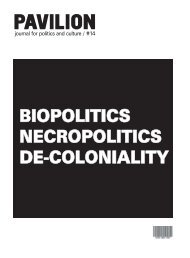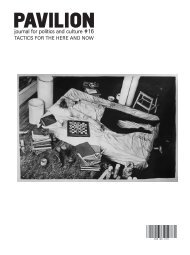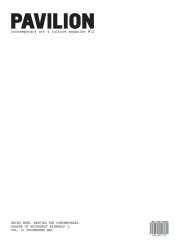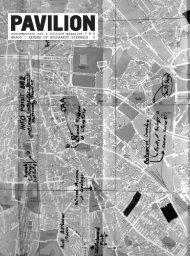PAVILION
PAVILION
PAVILION
- No tags were found...
You also want an ePaper? Increase the reach of your titles
YUMPU automatically turns print PDFs into web optimized ePapers that Google loves.
naïve. Form and content are held together<br />
at the expense of all historical and<br />
political complexity, to the point of removing<br />
the event - the death of Andreas<br />
Baader - from the present, and turning it<br />
into the occasion for a crude propaganda.<br />
Yet it is precisely this crudeness that<br />
offers it an element of redemption, since<br />
it gives it an aspect of anti-art (art-historical<br />
repetition as lack of contemporareity)<br />
that, pardoxically, helps make it a ‘contemporary’<br />
work.<br />
Alternatively, something like Sigmar<br />
Polke’s Risk Game, 2002 (fig. 5) continues<br />
to mine the seam of the readymade,<br />
in the spirit of Richter’s photo-paintings,<br />
leaving the determination of the structure<br />
of the image to the participants themselves.<br />
The artistic act here is primarily<br />
that of selection (a market model of<br />
autonomy as choice), with the composition<br />
of the image itself internalized to the<br />
practice of representation/communication<br />
that is artistically re-presented. This<br />
relies upon a type of auto-representation<br />
of history that found its archetypical contemporary<br />
form in the images of abuse of<br />
Iraqi prisoners taken by US troops in<br />
Abu-Ghraid (figs 6 and 7).<br />
So far, I have located the question of the<br />
political within contemporary art only at<br />
the very general structural level of the<br />
dialectic of autonomy and dependence.<br />
However, as these examples show, the<br />
more concretely political meaning of<br />
these structural aspects (primarily, ‘freedom’)<br />
depends upon the dialectic of individuality<br />
and collectivity at play within ‘the<br />
law of form’.<br />
(ii) The dialectic of individuality and collectivity<br />
(or, the crisis of mediations)<br />
The dialectic of individuality and collectivity<br />
at play within the law of form in works<br />
of contemporary art may be summarized,<br />
briefly, as followed.<br />
1. The individuality of the work of art is<br />
the ontological marker of its autonomy -<br />
its autonomous production of meaning<br />
(production of the self-conscious illusion<br />
of an autonomous production of meaning)<br />
- and the basis of its constitution as<br />
an enigma. This enigma lies in the fact<br />
that in their autonomous meaning-production,<br />
works of art act like subjects.<br />
They are objects that act like subjects -<br />
human subjects, individual bourgeois<br />
subjects - the subjectivity of which consequently<br />
remains opaque. As such, they<br />
draw attention to the objecthood, and<br />
hence opacity, of human subjects themselves,<br />
and thereby to the illusion constitutive<br />
of the philosophical concept of the<br />
subject itself. That dialectical transformation<br />
of the object into a subject that is the<br />
work of art is matched, epistemologically,<br />
by a dialectical reversal of the human<br />
subject into an object, which renders subjectivity,<br />
in itself, opaque.<br />
2. However, meaning is collective.<br />
3. The work of art must thus mediate its<br />
ontological individuality with the collectivity<br />
of its (potential) meanings. This is the<br />
function of its self-legislating ‘law of form’.<br />
Form is the artistic mediation of the<br />
social, at a whole range of levels, from<br />
artistic materials (including technologies<br />
of production) to techniques and productive<br />
practices.<br />
4. If politics is an active constitution or<br />
construction of the social, then the political<br />
aspect of art here will lie in the con-<br />
structive aspect of form, in the construction<br />
of form as mediation. Questions thus<br />
arise as to what are the main forms of<br />
mediation of the individuality of works of<br />
contemporary art with the collectivity of<br />
their meanings; and what are their political<br />
significances?<br />
These questions are complicated by the<br />
peculiarity of social form in capitalist societies.<br />
For in capitalist societies ‘collectivity’<br />
is itself already formal: abstract and<br />
alienated via exchange relations and the<br />
commodity form. Famously, exchange<br />
relations break down historically received<br />
collective meanings. In this respect, ‘the<br />
social’ in its distinctively capitalistic sense<br />
(as opposed to the communal) is not a<br />
‘collective’ form in any positive politically<br />
meaningful sense. Capitalistic sociality<br />
(the commodity/the value form) produces<br />
‘individuals’ who are united only in the<br />
mutual alienation of their sociability, in a<br />
new kind of what Kant called ‘asocial<br />
sociability’. Yet such individuality has<br />
nonetheless, historically, provided the<br />
model of freedom; hence the political<br />
centrality of libertarianism - of all stripes -<br />
to capitalist societies. Yet absolute individuation<br />
destroys meaning. This is the<br />
contradiction at the heart of what Adorno<br />
calls the growing ‘nominalism’ of modern<br />
art, which is essentially a crisis of mediations.<br />
In Adorno’s Aesthetic Theory, nominalism<br />
is not an abstract philosophical position<br />
about the status of universals, but a<br />
socio-historical claim about the declining<br />
artistic significance of objective aesthetic<br />
norms. ‘The universal’, he writes, ‘is no<br />
longer granted art through types and<br />
older types are being drawn into the<br />
whirlpool.’ Individual works are forced to<br />
establish relations to universality - including<br />
the universality of ‘art’ itself - in new<br />
ways. This tendency towards a ‘prohibition<br />
on predefined forms’ is inherent in<br />
the modern conception of art as such, in<br />
the ‘progressive particularization’ out of<br />
which the aesthetic conception of the<br />
work as an expression of subjective freedom<br />
emerged, in opposition to subsumptive<br />
models of judgement. However, once<br />
the principle of individuation becomes a<br />
‘directive’ - and hence a new form of<br />
abstract universality of its own - it threatens<br />
the structure of the work with a<br />
reduction to its materials: ‘Unchecked<br />
aesthetic nominalism … terminates in a<br />
literal facticity’. Adorno presents this situation<br />
as something of an impasse, an<br />
‘historical aporia’. 25<br />
However, there is more dialectical movement<br />
in the situation than this formulation<br />
suggests. For if modern art is to be true<br />
to its rejection of received universals in<br />
the name of subjective freedom, it must<br />
also reject the absolutization of its own<br />
inherent nominalism, and enter into new<br />
kinds of relations with universals - both<br />
old and new. If contemporary art has<br />
social substance to the extent to which it<br />
‘gives shape’ to the antinomy of aesthetic<br />
nominalism by ‘winning form from its<br />
negation’, this need not be a merely negative<br />
dialectic. Rather, it requires new<br />
forms of mediation. Indeed, this was the<br />
historical significance of isms for Adorno<br />
himself: those ‘programmatic, self-conscious,<br />
and often collective art movements’,<br />
which, in their day, ‘by no means<br />
shackle[d] the individual productive<br />
forces but rather heighten[ed] them … in<br />
part through mutual collaboration.’<br />
However, despite this crucial mediating<br />
function, Adorno has a predominantly<br />
[128]<br />
[129]








